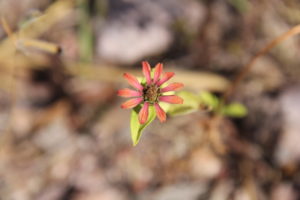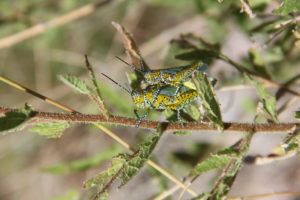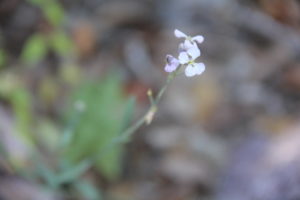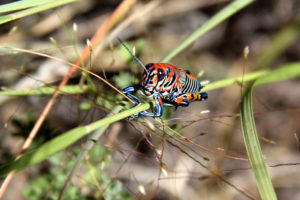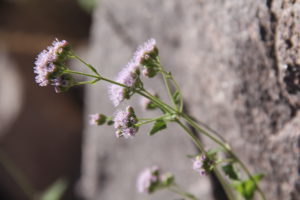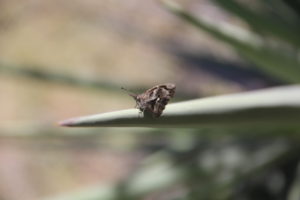
Tall grasses dance in waves as the wind whispers through the canyon of Coronado National Memorial, gently greeting every being on its way to the open valley below.
The serenity of being completely surrounded by the natural world cannot be taught, bought or superficially manufactured. It is an experience unique to itself, to the place and moment. Most natural spaces which we can have such experiences, are made possible through public lands. Public lands constitutes 40 percent of the total lands in Arizona.
In celebration of National Public Lands Day, the Coronado National Memorial hosted a pollinator bioblitz, a collective effort to set out, and record/ identify (if possible) as many species as possible within a given specific area.
“We’re incorporating this project in because it gives the public, and citizen scientists/ naturalists who already have an interest in the biodiversity of the area, the opportunity to be a scientist. And they’re contributing to the data that’s going to help us in the future,” said Christopher Bentley, a park ranger at Coronado National Memorial.

Citizen scientists are regular people, not necessarily from a scientific background.
In addition to local and visiting park rangers, this bioblitz was led by Mirna Manteca, a Sky Island Alliance Mexico Conservation Manager.
Pictures and observations from the event become part of a database which can be referenced in the future. Using an application called Inaturalist, participants upload their photos of flora and fauna. The species can then be identified by the recognition tool, or by fellow iNaturalist observers.
“That [collection of pictures and observations] goes to help us inventory the park.” said Bentley. “As we know, there will probably be changes in the future and we’re interested in what those changes are going to be.”
The bioblitz was geared around pollinators, which includes more than just bees, explained Bentley. Pollinators include all types of insects that are attracted to flowers and help spread pollen. Pollinators vary from butterflies to bats and some types of birds as well.
“I like the idea of taking a very broad definition of pollinator,” said Bentley, emphasizing that though pollinators are important, “the general public being engaged with what they are seeing in the park, no matter what it is, is equally important.” It is all about having a heightened sense of what is in the world around us, explained Bentley.

Besides compiling photos/data for the app, Manteca emphasizes that the bioblitzes also promote community involvement. “We can use pollinators and blitzes as a tool to bring people out, and have them open their eyes to these amazing, amazing places and resources,” said Manteca. “Everyone likes butterflies right? Bees are awesome. We are gathering data for the park, but at the same people are just so happy hiking around and looking at spiders and being in nature.”
Visiting from the other side of the border, were students from the University of Sonora. Though the same ecosystem of Coronado National Memorial continues to exist well into Northern Sonora, Mexico, this was Anays Blanco’s first time, as well as many other students’ first “adventure in nature”, and first participation in a bioblitz. Blanco explained that public lands are not really a “thing” in Mexico that are celebrated, protected and advocated to the same degree as they are in the US. “These kinds of experiences are where we learn the most,” said Blanco.

Building a strong connection to nature is something that Carianne Campbell of the Sky Island Alliance also emphasizes.“National public lands day is a really great annual event because it is a concentrated effort where volunteer events happening across the country, highlighting the value of our public lands and getting people out there,” said Campbell. “We want to create advocates who are connected to nature and care about it and want to protect it and enjoy it, that is really what public lands day is really about.”
Much of the local “on the ground“ conservation work the Sky Island Alliance hosts, are in public lands like Saguaro National Monument, Tumacacori National Historical Park, and Sabino Canyon. An invasive species pull, removal of non-native plants, was simultaneously held on the same day at Sabino Canyon, according to Campbell. A replanting pollinator oriented native species the weekend following.
The vast majority of our public lands, especially here in Arizona are managed by the Bureau of Land Management, the National Forest Service, and the National Park Service. They are the main institutions we pay taxes to, in exchange, they manage and take care of. All of which tend to get quickly lumped together, but there are differences in their mission statements and how the lands are managed depends on ownership.
Bentley resonated with the National Park Service for that specific reason. “National Park Lands are very strictly managed, it’s our mission is to preserve and protect these lands. We would never open national park lands to the possibility of drilling oil, for example. That would go directly contrary as to why the park was established,” said Bentley. “That’s why I work for the park service. I believe in the mission.”
Though the public lands under the National Park Service are strictly managed and fiercely protected from industry and corporations. Steering away from private interests, like mining and drilling, is not exactly the case for the public lands under the BLM and the National Forest Service. It is all of their duties to protect important environmental concerns, or a species that is listed as endangered, or even the just plain breathtakingly scenic, if agreed upon by congress. However, the BLM and NFS lands are “multiple use” which means they are open game to the highest bidding mining and drilling companies, more of than not, at the expense of the environment.
The recent reduction of Bear Ears National Monument and Grand Staircase–Escalante National Monument in Utah, are examples of recent perils public land are currently facing. Closer to home, the Rosemont Mine in Coronado National Monument is still on track to deflower the base of the Santa Rita mountains. Tonto National Forest has also been targeted for profiteering by Resolution Mine.

Just down a few miles from Coronado National Memorial, is the one of Arizona’s last free-flowing perennial streams, the San Pedro River. The public comment period for the BLM’s Draft Resource Management Plan and Environmental Impact Statement ended Sept. 29. The draft acknowledges the BLM’s “preferred” alternative, which would authorize livestock grazing along a large portion of the river.
The National Environmental Protection Act provides an opportunity for environmental, cultural, economic and climate change impacts to be assessed. It also provides an avenue for anyone to give input on actions that federal agencies are taking on their lands, explained Carianne Campbell. “I think it is particularly important for students to understand that public process, as well as how they can be engaged in it,” said Campbell.
“Now is a really important time to be engaged in these questions and maybe understand the differences between what their public lands are and some of the concerns that people might have about the state of their public lands,” said Bentley. “The biggest threat is when people don’t care anymore.”
Click here for word document and high resolution photos.
Monique Irish is a reporter for Arizona Sonoran News, a service from the University of Arizona School of Journalism. Contact her at mirish1@email.arizona.edu

